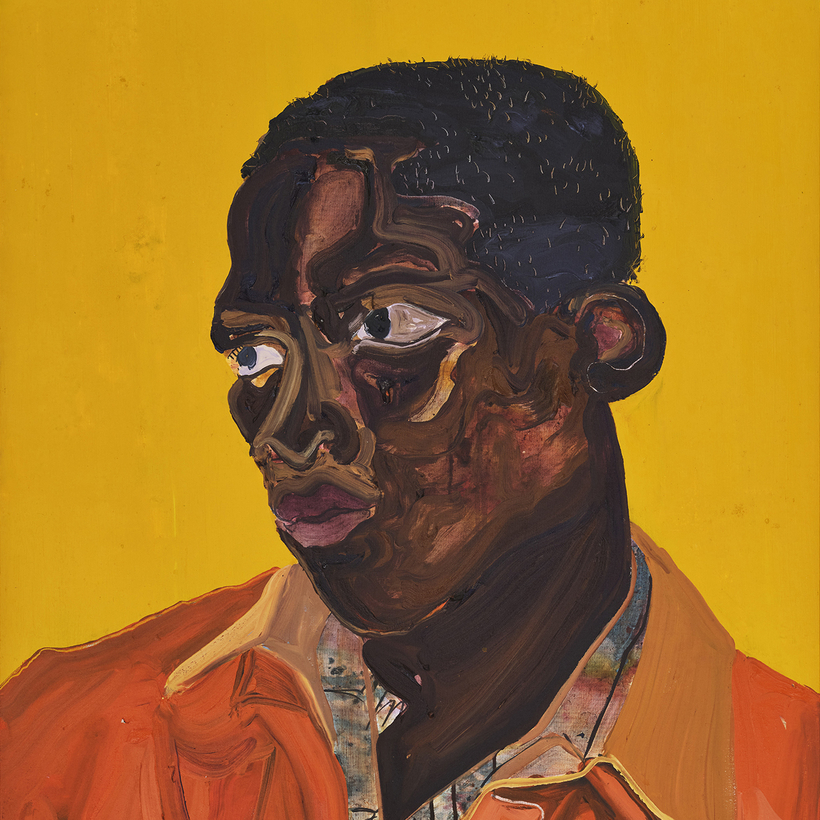When I visited the painter Ludovic Nkoth in his airy, plant-filled Montmartre studio this summer, he was preparing for three shows, in Los Angeles, Milan, and Paris. Known for his expressive, gestural use of paint and his commitment to placing Blackness at the center of portraiture, Nkoth, 28, has found himself in high demand.

Hanging on the walls were a few of his richly colored canvases. They depicted old friends and family from the U.S. as well as new acquaintances he’d met in Paris while completing a residency at the Académie des Beaux Arts x Cité Internationale des Arts. Among the paintings was High Notes, an arresting double portrait of a pair of musicians he’d met on the street in Château Rouge, a neighborhood popular with African migrants. It’s now on view in his solo show at François Ghebaly, in Los Angeles.
At the center of Nkoth’s practice is an interest in the complexity of the Black-diasporic identity. Nkoth was born in Cameroon, but, at 13, he and his family moved to South Carolina. He then moved again, to New York, for graduate school. First African, then African-American, and now, after a year of living in France, African-European, he explains.

In particular, Nkoth is interested in the stories of other immigrants, of how they make their way in the world, and how they understand the idea of home. “Does an individual change place, or does the place change the individual?” he muses. Nkoth is philosophical, and despite his warm demeanor, it’s clear from the scribbled notes pinned to the studio walls that he spends a lot of time alone with his thoughts. At one point, he asks, “What would have happened if I stayed in Cameroon?”

Nkoth’s first language is French, but since moving to Paris and talking again in his native tongue, he’s felt alienated by an increasingly nativist, right-wing France. Francophone/Anglophone (School Girls), now on view at Maison La Roche, in Paris, features a group of Black schoolgirls whispering and eyeing each other with suspicion, perhaps expressing his ambivalence about the country.

Nkoth’s reception in the Parisian art world has been warm. He’s recently collaborated with two hallowed French institutions. Dior tapped him to design a special edition of their Lady handbag, which will be available in select stores beginning December 7. The bags play with the motifs of West African masks and cowrie shells, subtly stitching Nkoth’s origins into the story of French luxury. While working with Dior, Nkoth collaborated with the estate of the French-Swiss architect Le Corbusier, which chose him for the Maison La Roche exhibition, on view through November 25.

Maison La Roche, nestled on a quiet block in the 16th Arrondissement, is operated by the Fondation Le Corbusier as a museum. It was designed as both a living space and private gallery for the wealthy yet ascetic banker Raoul La Roche. Considered the first of Le Corbusier’s structures to illustrate all five of his manifesto’s principles, the home features the large volumes, bold colors, and simple geometry that made Le Corbusier one of the godfathers of modernism. Like many of his peers, Le Corbusier’s investigations into abstraction were heavily inspired by art from Africa, and he was a keen collector of African masks. But Nkoth will be the first African artist to exhibit work there.
“For me, this is a step into breaking that history by inserting myself,” he says. In the show, he’s offering a different story for the space: “What if this house was owned, or lived in, by a Black family?” Hence the show’s title, “What If.”

Today, the scenario of such a family living at the center of the contemporary-art scene is not hard to imagine. (Just look at the collection of Alicia Keys and Swizz Beatz.) And yet, for many of the newly arrived immigrant subjects in these paintings, that life remains inconceivable. The gap may still be wide, but with deft paint handling and emotional depth, Nkoth is trying to bridge it.
“The Is of It” is on at François Ghebaly, in Los Angeles, through November 11. “What If” is on at Maison La Roche, in Paris, through November 25
Check out AIR MAIL’s Arts Intel Report, our newly revamped research tool for what to do and where and when to do it
Daniel Penny is a U.K.-based journalist and critic

